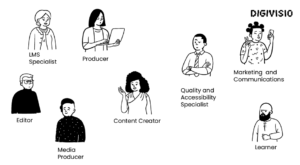Micro content is a fantastic method of presenting information and structuring learning. Each piece is focused on a singular issue and conscisely presents the necessary information. These bite-sized pieces of content can be stacked together to create larger learning entities, such as courses. Micro content can help reduce the cognitive load associated with more traditional teaching methods, making it particularly well suited to the demands of modern working life and education on social media platforms.
| Our vision for the “Producing Micro Content in a Team” course is to ensure that anyone, regardless of pedagogical background or training, can learn about micro learning in an accessible manner. So they can understand the reasons for creating micro content and how to do so effectively. We aim to provide everyone with the tools necessary to create their own educational content and micro courses. |
|
We also wanted to provide higher educational institutions with the means to support content creators in creating micro content. Additionally, we provided templates for assembling production teams and a model to systematize the content creation process. With this dual focus, our material can benefit both novices and experts alike.
Working simultaneously in two languages
One unique feature of our collaboration was its bilingual nature. Originally from the United Kingdom, Cai is far more comfortable using English to express his ideas than Finnish. Hannele, being from Finland, is naturally more expressive in Finnish. Rather than just picking and using a single language for communication, we decided to work in both languages simultaneously.
This bilingual approach enriched our cooperation and provided new ways of thinking about the same content. This was particularly useful in the content creation phase, as we might have to explain the same thing in different ways. It kept us focused on the core elements someone working their way through our material would need to know.
Sharing & Growing Professionally
What surprised us was how professionally we both developed while creating the course. We each had a unique skill set, and creating a course of this size and scope together provided opportunities to learn from one another. We constantly peer-reviewed each other’s work in a positive and constructive way, which helped us develop a safe, collaborative space for professional growth.
 Working in support services, we often consider ourselves customer-focused rather than experts in our own right. This is, of course, true, but developing a course that helps others create educational micro content reinforced our sense of professional identity.
Working in support services, we often consider ourselves customer-focused rather than experts in our own right. This is, of course, true, but developing a course that helps others create educational micro content reinforced our sense of professional identity.
The course is a visible demonstration of our competence as learning and pedagogical specialists. Creating this material allowed us to reflect on our practices and develop our subject knowledge. We also needed to follow the latest discussions in educational research to ensure our content was relevant and current.
So many of us work alone when we produce educational content and resources, but working collaboratively can be a really rewarding experience.


